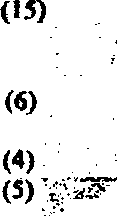Cochin University of Science and Techology (CUST) 2008 B.Tech Electronics and Communications Engineering 405 ANALOG COMMUNICATION - Question Paper
ANALOG COMMUNICATION
BTS(C)-IV- 08- 015-E
B. Tech Degree IV Semester Examination April 2008 p
EC/EE 405 ANALOG COMMUNICATION
(2006 Scheme)
Time: 3 Hours Maximum Marks: 100
PART- A (Answer ALL questions)
(8x 5-40)
I, (a) Define modulation. What are the needs for modulation?
(b) Explain any one method for SSB generation.
(c) What are the advantages and disadvantages of FM over AM.
(d) Explain the principle of FM generation. Draw and explain a direct FM generator circuit.
(e) Define thermal agitation noise. An RF amplifier operating at 17C has 200 Q equivalent noise resistance and 300 input resistor. Calculate the rms noise voltage at the input to this amplifier. The band width of this amplifier is 6MHz. (Value of Boitzman's
J
constant= 1.38x 10-23./ / K)
(0 DefineSelectivityand 'Sensitivitywith regard to a receiver. .
(g) Explain Pulse signalling and DTMF signalling used to telephony. v
(h) Explain the terms grade of service and blocking-probability in telephony.
rJ
PART-B i
4
II. (a) Draw an AM wave, with regard to a sinusoidal input signal and derive the expression for ;
modulation index m from am AM wave diagram.
(b) Derive the mathematical expression for an AM wave and draw its frequency
spectrum. Discuss about bandwidth required for A.M. (8)
OR I
If!. (a) Explain the working of a super heterodyne receiver with the help of a block diagram. (8)
(b) What is the principle of a double super heterodyne receiver? Discuss its advantages (7) *
IV. (a) Explain the Indirect method for F.M generation with relevant diagrams. (10)
(b) Discuss about band width requirement of an F.M system. (5)
OR
V. Explain the principle of a slope detector. Explain a balanced slope detector with J* circuit and necessary diagrams. (IS)
<
VI. Explain in detail, various types of noises that are affected upon a receiver.
(15)
(9)
(6)
OR
VII. (a) Define (i) Signal to noise ratio
(ii) Noise factor and noise figure
(iii) Effective noise temperature.
(b) Define AGC in a receiver. Discuss how it affects the performance of a receiver. Compare simple ACC and delayed AGC.
Explain the mechanism of a Strowger Switch with neat diagram. Compare between a 'uniselector" and a two motion selector.
VIII.

OR
(a) Define the terms busy hour", BHCA and **CCR with regard to telephone traffic engineering.
(b) An exchange serves 2000 subscribers. If average BHCA is 10,000 and CCR is 60%, calculate busy hour calling rate.
(c) Write short notes on Time Division Switching.
IX.
|
Attachment: |
| Earning: Approval pending. |
